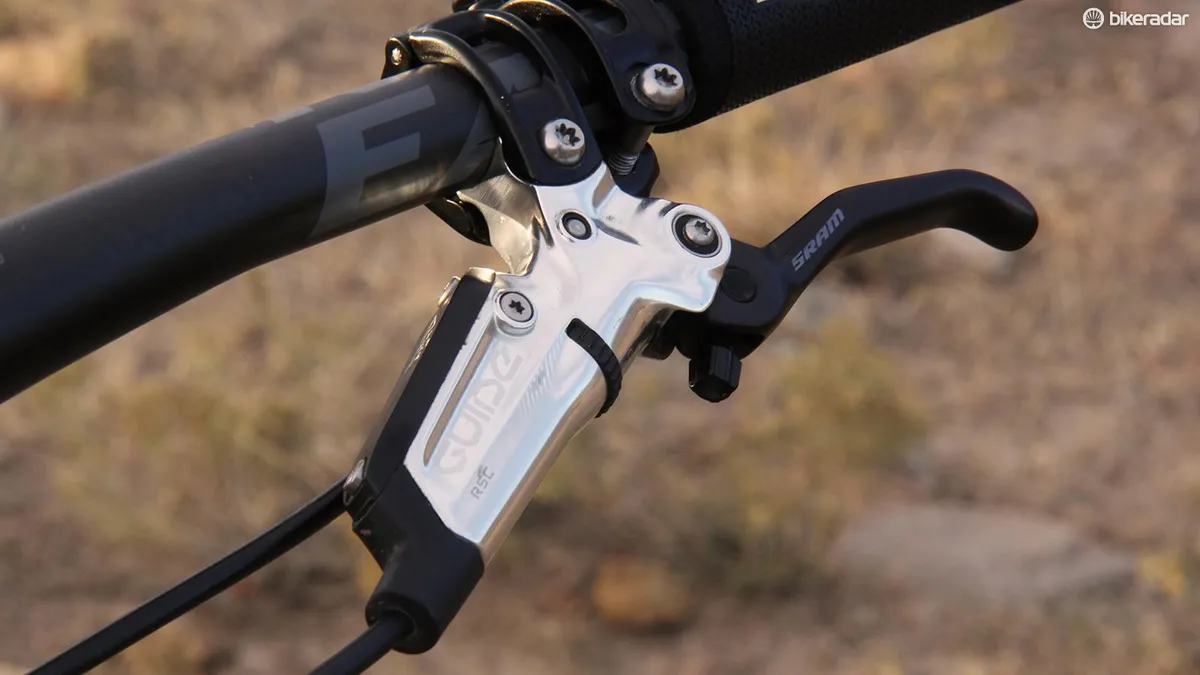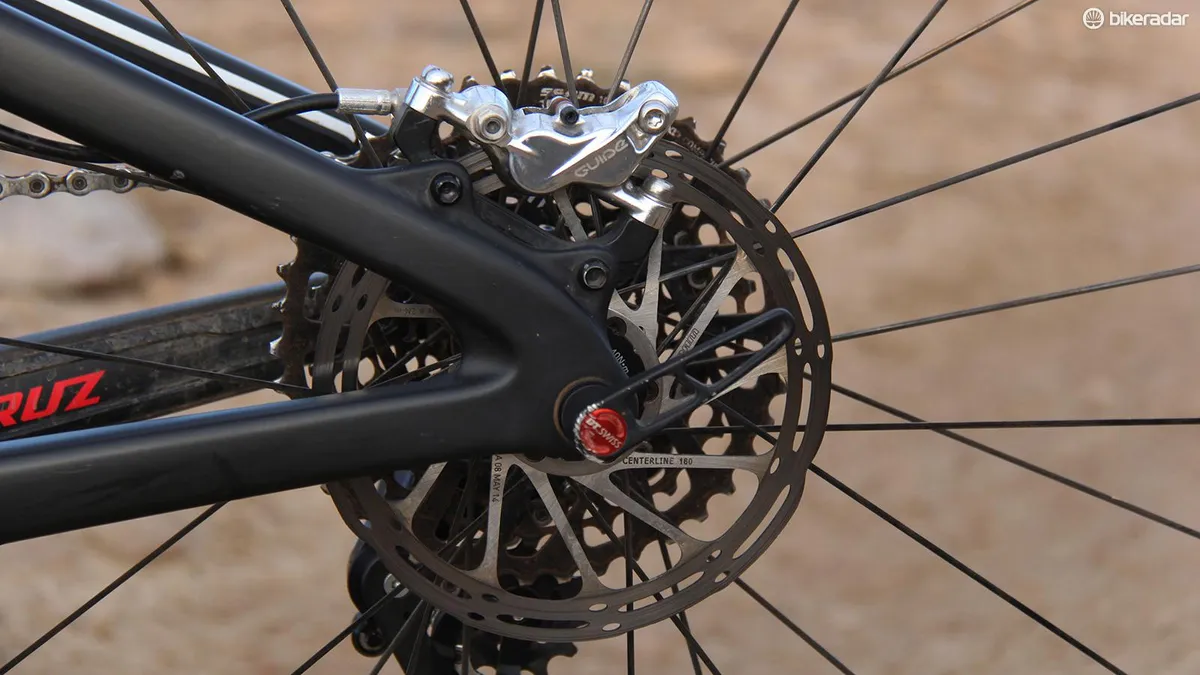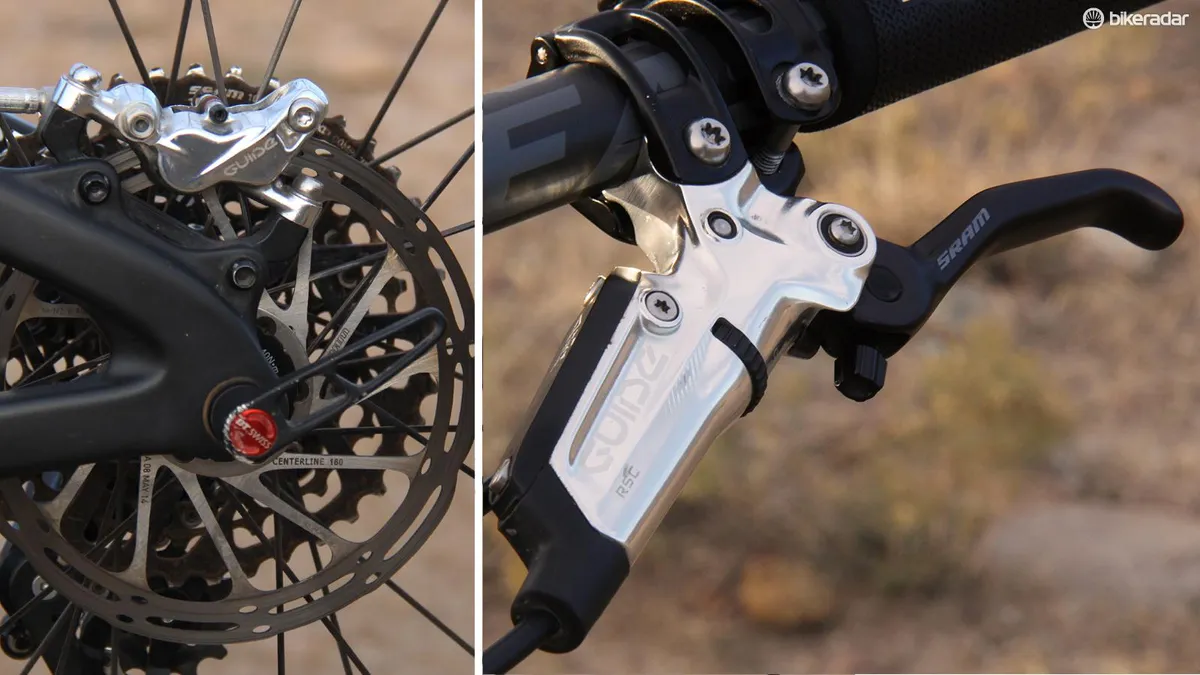Robust, consistent, powerful and lightweight were the four criteria SRAM’s brake engineers were aiming to meet when they started developing the Guide brake two years ago.
The process began by taking a hard look at the competition and making note of what worked and what didn’t. The result of this competitive analysis is a new brake platform that has shed the most common issues associated with past SRAM / Avid brakes, while maintaining robust braking power and improving lever feel and overall adjustability.
We spent six months testing the Guide RSC brakes to see how they would hold up under a season of hard riding.
- Highs: Excellent modulation; easy to fine-tune lever feel
- Lows: Slight weight gain over the brake system it replaces
Related reading: Complete breakdown of the three new Guide brake systems
On the trail
“Dancing around the edge of lock-up,” is how James Alberts, SRAM’s mountain bike brake product manager, described the Guide’s performance. We found it to be an apt description. We were always able to find the sweet spot between locking up the brakes and providing just enough power to slow our roll while maintaining traction. We were never left wanting for power.
Under hard braking, the Guides feel quite similar to the X0 Trail brakes they replace, though it’s their ability to deliver subtle amounts of braking power that make them stand out.
The modulation of the Guide brakes is better than any of SRAM's previous brakes. The range between feathering the brake and locking up the wheels has been markedly increased. The result is predictable, controlled braking performance, that allows riders to scrub the bare minimum speed needed to maintain traction.

The Guide lever offers independent reach and contact point adjustments, and uses a cam system, dubbed Swinglink, to provide a progressive leverage curve for improved modulation
Ergonomics, too, are improved. The independent reach and contact point adjustments make it easy for riders dial in their preferred amount of throw and lever position.
No more bubble trouble
In the interest of being thorough, we bled our Guide RSC brakes three times during six months of testing. The first bleed came after cutting the hydraulic hoses to length for our test bike — a standard practice for any new brake installation to ensure it’s performing at its best.
The second bleed came after three months of testing. We wanted to see how the brakes had fared and whether any air had entered the system. After finding the lines clean and clear, we actually added a small bit of air to the system, to see how the Guide brakes would cope with a less than ideal bleed.
We did this because one of SRAM’s claimed improvements is that the new in-line master cylinder and higher volume piggyback reservoir are more tolerant of air bubbles than the previous TaperBore design, which could be quite finicky if not properly bled by the factory or the end user.
SRAM’s claims of a more tolerant system proved true: the air we added quickly migrated from the hydraulic lines back into the reservoir, allowing the brakes to function normally. We rode the brakes with this “half-assed home mechanic bleed” for two weeks without incident.
The third and final bleed was simply to clear the air from the lines. It's worth noting that the Guides use the same bleed kit and the same straightforward bleed process as past SRAM/Avid brakes.
Pads and rotors
All three versions of the Guide brake use the same four-piston caliper introduced two years ago on the X0 Trail brake. We burned through two sets of metallic brake pads during out test, which was acceptable, given the mileage and conditions we rode in.
We found that lever feel remained unchanged through approximately 50 percent of the lifespan of the brake pads. Beyond this point we had to readjust the contact point. (You could also use the old trick of removing the wheel and pumping the brake lever just enough to move more fluid from the reservoir to the caliper.) SRAM recommends replacing the pads once they are worn to less than 0.04mm.

One admirable feature that went almost went unnoticed during our testing was the supreme silence of SRAM’s new Centerline rotor design in dusty as well as wet conditions — no gobbling, squawking, warbling or any other bird calls that have absolutely no place on a bicycle.
How the Guide RSC stacks up against the competition
The highest praise we can give the Guide RSC is that it is a worthy competitor to Shimano’s much lauded XT and XTR Trail brakes. For the first time in a very long time, the SRAM versus Shimano brake debate does not hinge on reliability, but rather, user preference.
Some riders may prefer the more compact Shimano lever design. Likewise, other riders may prefer the wider range of modulation offered by SRAM. In our opinion, both companies' brake systems are now good enough that these issues of ergonomics and lever feel boil down to personal preference.
Verdict
SRAM did its homework in designing the Guide RSC brake. Through six months of rigorous testing, our pair performed without incident.
The range of modulation is outstanding and our reservations about reliability have been assuaged. If SRAM can incorporate the technology developed for Guide into the rest of its brake line, riders and mechanics will be singing its praises.


